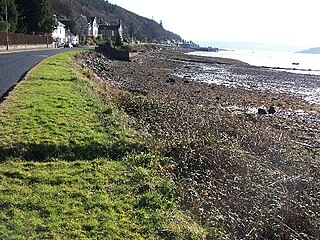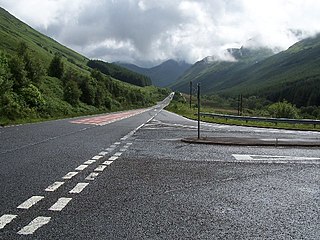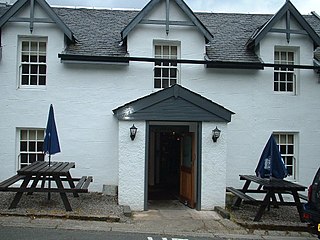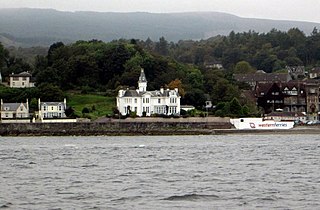
Dunoon is the main town on the Cowal peninsula in the south of Argyll and Bute, Scotland. It is located on the western shore of the upper Firth of Clyde, to the south of the Holy Loch and to the north of Innellan. As well as forming part of the council area of Argyll and Bute, Dunoon also has its own community council. Dunoon was a burgh until 1976.

Loch Long is a body of water in Argyll and Bute, Scotland. The Sea Loch extends from the Firth of Clyde at its southwestern end. It measures approximately 20 miles (32 km) in length, with a width of between 1 and 2 miles. The loch also has an arm, Loch Goil, on its western side.

Kilmun is a linear settlement on the north shore of the Holy Loch, on the Cowal peninsula in Argyll and Bute, Scottish Highlands.It takes its name from the 7th century monastic community founded by an Irish monk, St Munn. The ruin of a 12th-century church still stands beside the Kilmun Parish Church and Argyll Mausoleum.

Strone is a village on the Cowal peninsula in Argyll and Bute in the Scottish Highlands at the point where the north shore of the Holy Loch becomes the west shore of the Firth of Clyde. The village lies within the Loch Lomond and The Trossachs National Park.

Kirn is a village in Argyll and Bute in the Scottish Highlands on the west shore of the Firth of Clyde on the Cowal peninsula. It now forms part of the continuous habitation between Dunoon and Hunters Quay, where the Holy Loch joins the Firth of Clyde. It originally had its own pier, with buildings designed by Harry Edward Clifford in 1895, and was a regular stop for the Clyde steamer services, bringing holidaymakers to the town, mostly from the Glasgow area.

Ardnadam is a village on the Holy Loch on the Cowal peninsula, Argyll and Bute, Scotland. It is located northwest of Hunters Quay and east of Sandbank, and sits across the loch from Kilmun.

The A815 is a major road in Argyll and Bute, Scotland. It runs for about 37 miles (60 km) from Toward in the south to the A83, near Cairndow, in the north.

Hunters Quay is a village, on the Cowal peninsula in Argyll and Bute, Scottish Highlands. Situated between Kirn to the south and Ardnadam to the north, Hunters Quay is the main base of Western Ferries, operating between Hunters Quay and McInroy's Point.

Dunoon Castle is a ruined castle located at Dunoon on the Cowal peninsula in Argyll and Bute, Scotland. The castle sat upon a cone-shaped hill of about 80 feet high, a volcanic plug. Very little remains of the castle's structure today. Castle House, built in 1822, stands a few yards north of the castle ruins.

Dunoon Primary School is a school in Dunoon, Argyll and Bute, Scotland. It is located in a Category B listed building dating from 1901.

Glen Lean is on the Cowal peninsula in Argyll and Bute, Scotland. It is an obvious glacial-formed glen, with near vertical sides along part of the glen. It runs from the head of the Holy Loch in the east to the head of Loch Striven in the west. The only hamlet in the glen is Clachaig. The Little Eachaig River flows out of the glen, joining the River Eachaig and flows into the Holy Loch. The Tarsan Dam is the other notable feature in the glen.

Loch Loskin is a freshwater loch in Ardnadam, Argyll and Bute, Scotland. The outflow from the loch is the Milton Burn, which winds its way through Dunoon to the Firth of Clyde. The A885 from Sandbank known as the "High Road" locally passes the loch.

The Whistlefield Inn is a Category C listed building in Whistlefield, Argyll and Bute, Scotland, about twelve miles northwest of Dunoon. Built in 1663, it was originally a drover's inn on the route between Strachur and Ardentinny. It sits about 1,300 feet (400 m) from the eastern shores of Loch Eck. Today, it is an inn and restaurant.

High Kirk, also known as the Old Parish Church, is a Church of Scotland church building in Dunoon, Argyll and Bute, Scotland. It is located on Kirk Street, just south of the town centre. Constructed in the Gothic revival style, it is a Category B listed building.

The George Hotel was a hotel and bar formerly located at today's 73 George Street in Dunoon, Argyll and Bute, Scotland. Now a private residence, it is a Category C listed building, built around 1800.

The Royal Marine Hotel is a hotel located on Marine Parade in Hunters Quay, Argyll and Bute, Scotland. It is a Category B listed building, opened in 1890 after the original 1856 building, named Marine Hotel, was gutted by fire. Its architect was Glasgow's Thomas Lennox Watson. The new construction received royal patronage in 1872.

Hunters Quay Hotel is a hotel located on Marine Parade in Hunters Quay, Argyll and Bute, Scotland. It is a Category C listed building, built around 1870. It sits a few feet to the south of the Royal Marine Hotel.

Kirn & Sandbank Parish Church is a Church of Scotland church building in Kirn, Argyll and Bute, Scotland. It also serves the population of nearby Sandbank. The church is located on Kirn Brae at its junction with Marine Parade, which leads to and from Dunoon, about a mile to the southwest. Constructed in the Romanesque style, it is a Category B listed building.

Dunoon Pier is a Victorian pier in the Scottish town of Dunoon, Argyll and Bute. Completed in its current form in 1898, and reaching out into the Firth of Clyde, its earliest parts date back to 1835. It is now a Category A listed structure and, according to Historic Environment Scotland, the best surviving example of a timber ferry pier in Scotland.
Invereck is a Category B listed building in Sandbank, near Dunoon, Argyll and Bute, Scotland. Dating to around 1886, it is located near the head of the Holy Loch.





















